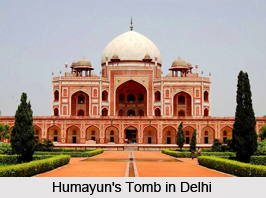 Humayun`s tomb in the capital city of Delhi is a fine specimen of the enormous Mughal architecture. It is a mausoleum for the Mughal Emperor, Humayun. Built in 1570, the tomb is of particular cultural significance as it was the first garden-tomb on the Indian subcontinent. Its unique beauty is said to have inspired several major architectural innovations, culminating in the construction of the unparalleled Taj Mahal. In many ways, this magnificent red and white sandstone building is as spectacular as the famous `monument to love` in Agra. This historic monument was erected by Humayun`s queen Hamida Banu Begam (Haji Begam) at a cost of about 1.5 million. It is believed that she designed the tomb.
Humayun`s tomb in the capital city of Delhi is a fine specimen of the enormous Mughal architecture. It is a mausoleum for the Mughal Emperor, Humayun. Built in 1570, the tomb is of particular cultural significance as it was the first garden-tomb on the Indian subcontinent. Its unique beauty is said to have inspired several major architectural innovations, culminating in the construction of the unparalleled Taj Mahal. In many ways, this magnificent red and white sandstone building is as spectacular as the famous `monument to love` in Agra. This historic monument was erected by Humayun`s queen Hamida Banu Begam (Haji Begam) at a cost of about 1.5 million. It is believed that she designed the tomb.
Humayun`s tomb is a complex building that is located in Nizamuddin East, New Delhi. During the reign of Slave Dynasty this land was part of the KiloKheri Fort which was capital of Sultan Kequbad Nasiruddin (1268-1287 AD). It encompasses the main tomb of the Emperor Humayun as well as numerous others.
History of Tomb of Humayun
Humayun, the eldest son of Babur, succeeded his father and became the second emperor of the Mughal Empire. He ruled India for nearly a decade but was ousted by Sher Shah Suri, the Afghan ruler. Humayun took refuge at the court of the Safavid ruler, Shah of Persia, who helped in regain Delhi in 1555 AD. Unfortunately, he was not able to rule for a long time and met with his untimely death after he fell from the stairs of the Sher Mandal library. The tomb of Humayun was built by the orders of Hamida Banu Begum, Humayun`s widow starting in 1562. The architect of the edifice was reportedly Sayyed Muhammad ibn Mirak Ghiyathuddin and his father Mirak Ghiyathuddin who were brought in from Herat. It took 8 years to build this Tomb and had a Charbagh, the first of its kind in the region.
Architecture of Tomb of Humayun
Humayun`s Tomb was a landmark in establishing some of the essential norms for later Mughal mausoleums in India. The tomb can be compared with the mausoleums of Timur and Bibi Khanam at Samarkand. It is set in the middle of a geometrically arranged garden. In Islam, there is a concept that paradise or jannat is a place set somewhere in the middle of the garden with water flowing through it. It is called the Charbagh as the entire garden is divided into four parts.
Humayun`s Tomb was the first garden tomb made in India. The garden is divided into 36 squares by a grid of water channels and paths. The square garden is surrounded by a high rubble wall divided initially into four large squares separated by causeways and channels, each square divided again into smaller squares by pathways creating a charbagh. The laying down of the gardens in the Persian style was introduced by Babur and continued till the period of Shah Jahan.
The structure is built mainly with red sandstone along with use of white and black marble to relieve the monotony. The marble is used largely in the borders. The dome is made of white marble. The Humayun`s tomb is the first Indian building to use the Persian concept of a double dome. The enclosure is entered through two eminent double-storeyed gateways, one on the west and the other on the south. The southern gateway remains closed nowadays. The baradari or the pavilion occupies the center of the eastern wall and the hamam or the bath chamber the center of northern wall.
High rubble walls enclose a square garden divided into four large squares separated by causeways and water channels. Each square is divided again into smaller squares by pathways, forming a typical Mughal garden called Charbagh. The fountains were worked with simple yet highly developed engineering skills quite common in India during this period. The last Mughal emperor, Bahadur Shah II had taken refuge in this tomb during the first War of Independence in 1857. Several rulers of the Mughal dynasty lie buried here. Humayun`s wife is buried here too.
Among others, there are graves of Akbar`s mother Dara Shikoh, Shah Jahan`s son and Bahadur Shah II, the last Mughal Emperor. The Humayun`s Tomb is a protected monument under the ownership of Archaeological Survey of India. It is the first significant example of the Mughal architecture with high arches and double dome, which occurs for the first time in India. It is also the first finest example of the garden-tomb, which culminated in the Taj Mahal at Agra. The design of the Taj Mahal is inspired from the Humayun`s Tomb. The Humayun`s Tomb is one of UNESCO`s World Heritage Sites. The Aga Khan Trust provided the funds for the restoration project of the Humayun`s Tomb. Since 2003, water has again started flowing from the fountains and water channels as it originally did. It is still maintained in its original grandeur.



















